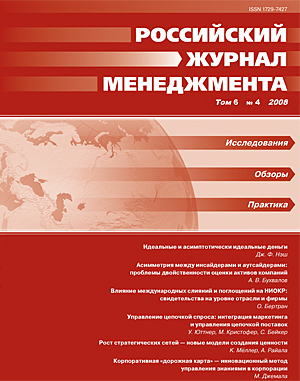Управление сетями: новые направления исследований
Скачивания
Данные скачивания пока недоступны.
Библиографические ссылки
ЛИТЕРАТУРА НА РУССКОМ ЯЗЫКЕ
Мёллер К., Райала А. 2008. Рост стратегических сетей — новые модели создания ценности. Российский журнал менеджмента 6 (4): 113–140.
Третьяк О. А., Румянцева М. Н. 2003. Сете вые формы межфирменной кооперации: подходы к объяснению феномена. Российский журнал менеджмента 1 (2): 77–102.
Юттнер У., Кристофер М., Бейкер С. 2008. Управление цепочкой спроса: интеграция маркетинга и управления цепочкой по ставок. Российский журнал менеджмента 6 (4): 83–112.
REFERENCES IN LATIN ALPHABET
Achrol R. 1991. Evolution of the marketing organization: New forms for dynamic environments. Journal of Marketing 55 (10): 77–93.
Achrol R. 1997. Chances in the theory of interorganizational relations in marketing: Toward a network paradigm. Journal of the Academy of Marketing Science 25 (1): 56–71.
Achrol R. S., Kotler P. 1999. Marketing in the network economy. Journal of Marketing 63 (4, Special issue): 146–163.
Benton W. C., Maloni M. 2005. The influence of power driven buyer/seller relationships on supply chain satisfaction. Journal of Operations Management 23 (1): 1–22.
Berry L. L. 1983. Relationship marketing. In: Berry L. L., Shostack G. L., Upah G. D. (eds.). Emerging Perspectives On Services Marketing. American Marketing Association: Chicago, IL; 25–38.
Bradach L. B., Eccles R. G. 1989. Price, authority, and trust: From ideal types to plural forms. Annual Review of Sociology 15: 97–118.
Brandenburger A. M., Nalebuff B. J. 1996. Coopetition. Doubleday: N. Y.
Corsten D., Kumar N. 2005. Do suppliers benefit from collaborative relationships with large retailers? An empirical investigation of efficient consumer response adoption. Journal of Marketing 69 (3): 80–94.
Cox A. 2004. The art of the possible: Relationship management in power regimes and supply chains. Supply Chain Management: An International Journal 9 (5): 346–356.
Cravens D. W., Piercy N. F., Shipp S. H. 1996. New organizational forms for competing in highly dynamic environments: The network paradigm. British Journal of Management 7 (3): 203–218.
Elg U. 2002. Inter-fi rm market orientation: Its signifi cance and antecedents in distribution networks. Journal of Marketing Management 18 (7/8): 633–655.
Fisher M. 1997. What is the right supply chain for your product? Harvard Business Review 76 (2): 105–116.
Håkansson H. (ed.). 1982. Internal Marketing and Purchasing of Industrial Goods — An Interaction Approach. Wiley: N. Y.
Håkansson H., Ford D. 2002. How should companies interact in business environments. Journal of Business Research 55 (2): 133–139.
Håkansson H., Snehota I. 1989. No business is an island: The network concept of business strategy. Scandinavian Journal of Management 5 (3): 187–200.
Jarillo J. C. 1988. On strategic networks. Strategic Management Journal 9 (1): 31–41.
Jeong Jung Sik, Hong P. 2007. Customer orientation and performance outcomes in supply chain management. Journal of Enterprise Information Management 20 (5): 578–594.
Jüttner U., Christopher M., Baker S. 2007. Demand chain management-integrating marketing and supply chain management. Industrial Marketing Management 36 (5): 377–392.
Kasabov E. 2007. Towards a contingent, empirically validated, and power cognisant relationship marketing. European Journal of Marketing 41 (1/2): 94–120.
Kohli A., Jaworski B. 1990. Market orientation: The construct, research propositions and managerial implications. Journal of Marketing 54 (2): 1–18.
Miles R. E., Snow C. C. 1986. Network organizations: New concepts for new forms. California Management Review 28 (3): 62–73.
Möller K., Svahn S. 2003. Managing strategic nets: A capability perspective. Marketing Theory 3 (2): 201–226.
Narver J., Slater S. 1990. The effects of market orientation on profitability. Journal of Marketing 54 (4): 20–35.
Oliver R. K., Webber M. D. 1982. Supply chain management: Logistics catches up with strategy. Outlook, reprinted in: Christopher M. 1992. Logistics: The Strategic Issues. Chapman Hall: London; 63–75.
Parolini C. 1999. The Value Net: A Tool for Competitive Strategy. John Wiley & Sons: Chichester, UK.
Polanyi K. 1957. The economy as instituted process. In: Polanyi K., Arensberg C., Pearson H. (eds.). Trade and Market in the Early Empires; Economies in History and Theory. Free Press: Glencoe, IL.
Porter M. E. 1985. Competitive Advantage: Creating and Sustaining Superior Performance. Free Press: N. Y.
Powell W. W. 1987. Hybrid organizational arrange ments: New form or transitional development? California Management Review 30 (1): 67–87.
Rainbird M. 2004. Demand and supply chains: The value catalyst. International Journal of Physical Distribution Logistics Management 34 (3/4): 230–250.
Slater C. C. et al. 1965–1974. LAFS/LAMP Research Reports. East Lansing.
Snow C. C., Miles R. E, Coleman H. J. 1992. Managing 21st century network organizations. Organization Dynamics 20 (3): 5–20.
Varamäki E., Vesalainen J. 2003. Modelling different types of multilateral co-operation between SMEs. Entrepreneurship & Regional Development 15 (1): 27–47.
Vollmann T., Cordon C., Raabe H. 1995. From Supply Chain Management to Demand Chain Management. IMD Perspectives for Managers, November.
Загрузки
Опубликован
09.12.2008
Как цитировать
Попов, Н. И., & Третьяк, О. А. (2008). Управление сетями: новые направления исследований. Российский журнал менеджмента, 6(4), 75–82. извлечено от https://rjm.spbu.ru/article/view/488
Выпуск
Раздел
Обсуждения и дискуссии: Новые концепции управления сетями
Лицензия
Статьи журнала «Российский журнал менеджмента» находятся в открытом доступе и распространяются в соответствии с условиями Лицензионного Договора с Санкт-Петербургским государственным университетом, который бесплатно предоставляет авторам неограниченное распространение и самостоятельное архивирование.





